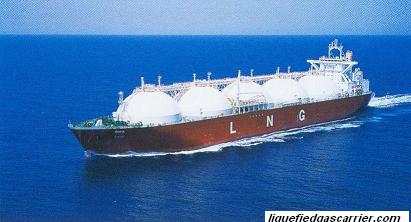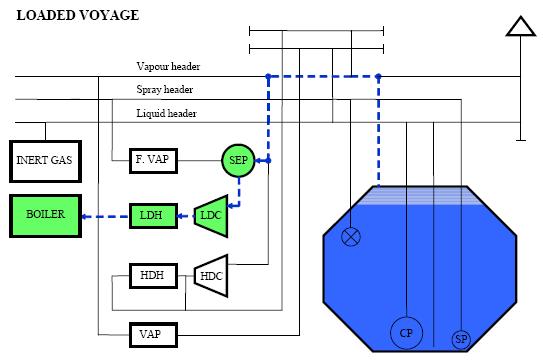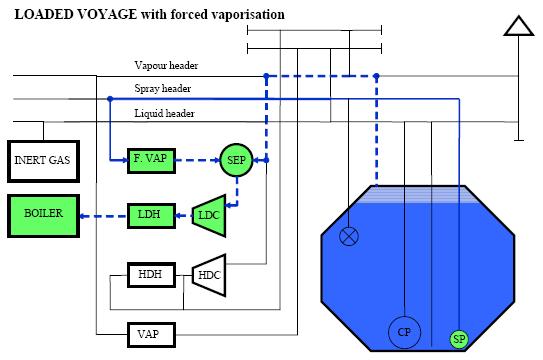

Home page|||
LNG handling |||
LPG handling||| Other Gas products|||
Fire & Safety|||
Emergency response |||
Laden voyage precautions for liquefied gas carriers
After loading cargo during a voyage from loading port to discharge port, even rigorously insulated cargo tanks are subjected to the inflow of heat from outside, due to that LNG which is boiling inside a tank, evaporates and increase the cargo tank pressure. When the cargo tank pressure rises above the set pressure of the relief valve of the cargo tank, the valve is actuated to release cargo vapors contained inside the cargo tank. LNG carriers are usually installed with a gas burning system, to maintain tank pressures below the set pressure of the relief valve.
During loaded voyage, LNG carriers always burn not only fuel oil but also vapors generated as mentioned above, so as to maintain cargo tank pressure. It may be noted that the principal operation of the Cargo Department on loaded voyage are the maintenance of cargo tank pressure and the control of cargo liquid temperature.

Throughout the loaded voyage, regular checks should be made to ensure that there are no defects in cargo equipment and no leaks in nitrogen or air supply lines. On LNG ships, it may be necessary to carry out visual cold-spot inspections of cargo tank surroundings even when the ships are fitted with temperature monitoring of the inner hull surfaces. Such inspections must comply with all relevant safety procedures for entry into enclosed spaces and due regard must be given to hazardous atmospheres in adjacent spaces.
While the vessel is at sea, cargo stored in the cargo tanks at low temperatures is heated as external heat from the seawater and atmosphere is transferred through the insulation of tanks. By the intrusion of the external heat, cargo is gasified, by which the tank pressure gradually increases. Therefore, in order to keep the tank pressure at a constant level, an operation is performed in which the vapor of LPG, Ammonia is recovered and reliquefied by the reliquefaction plant on board the vessel and in which the liquid is returned to the tank.
Operation of Reliquefaction and Liquid Return
This operation is carried out separately for propane and butane. Boil-off gas is drawn from the vapor suction of each tank with compressors and reliquefied by using the reliquefaction plant. The liquid thus liquefied is returned to tanks through the condensate return line from the bottom of each tank.
Liquid Level Control
Attention should be paid to the liquid level of each tank when the reliquefied liquid is returned to tanks to avoid overfilling.

Fig:LNG carrier laden voyage
During the loaded voyage, the boilers use natural boil off gas generated in the cargo tanks and
forced boil off gas supplied via the forcing vaporizer if necessary.

Fig:LNG forced vapourization
Both the natural and forced BOG are to be supplied to the boiler through an L/D compressor and
L/D heater.
On the loaded passage, the most important aspect that needs to be considered is controlling the
tank pressures and consequently dealing with excess vapour.
Unless otherwise instructed by the charterer, the fuel gas burning shall be adjusted so that the
vessel has the same tank pressure on arrival at the discharge terminal as it had after completion of
loading.
BOG rate should not be forced above vessel design limit unless otherwise instructed by the
charterer or owner.
It is important to arrive at the pilot station at the discharge port with a tank pressure that allows
for pressure increases when the ship is manoeuvring and no longer capable of burning the entire
vapour from the tanks.
The compressor used for fuel gas supply shall be operated at a steady flow that equalizes the
normal boil of rate.
Be aware that the tank pressure will increase in rough weather, but will drop again in calm
weather.
Line up for supplying natural BOG is carried out after completion of final gauging.
Related Information:
- The risk of ballast voyage - a brief guide to liquefied gas carriers
- Cargo Machinery Room Precautions
- Fire hazards and precautions - Sources of Ignition in Liquefied Gas Carrier
- Use of cargo as fuel -Cargo conditioning, reliquefaction and boil-off control for LNG carriers
- Fire hazards and precautions - Atmosphere Control For Gas Carrier
Reactivity of liquefied gas cargo
Toxicity and associated health hazards in liquefied Gas Carrier
Liquefied gases - How to remove all cargo liquid from tanks
Preparatory operations for drydocking
Discussion prior to cargo transfer in liquefied gas carrier
Handling LPG And ammonia cargo - preparation for loading
The risk of discharging cargo - a brief outline to liquefied gas carriers
Connection and disconnection of cargo hoses and hard arms

// Home page///
LNG handling ///
LPG handling///
Sea transport ///
Gas products///
Cargo work
///Fire precautions
///Health hazards
///Safety Precautions
///Emergency response ///

Copyright © Liquefied Gas Carrie.com All rights reserved.
The content published in this website are for general reference only. We have endeavoured to make the information
as accurate as possible but cannot take responsibility for any errors. For latest information please visit www.imo.org .
Any suggestions, please Contact us !
///Links &Resources //
Terms of use///
Privacy policy///Home page///
